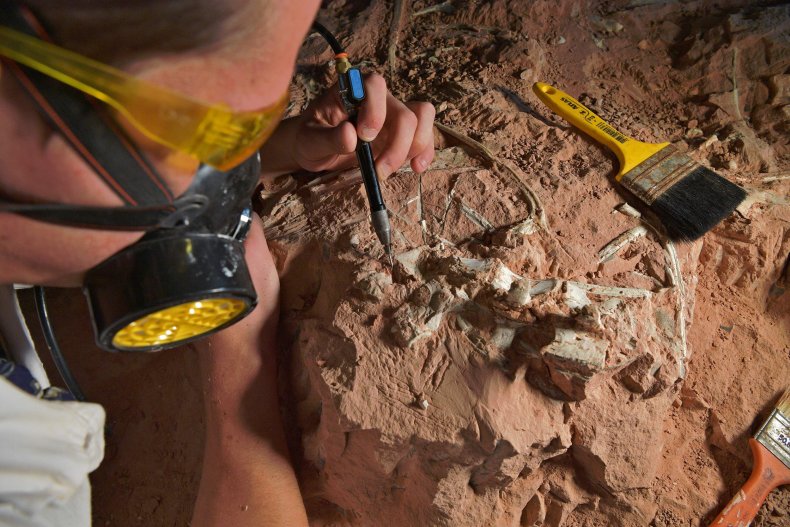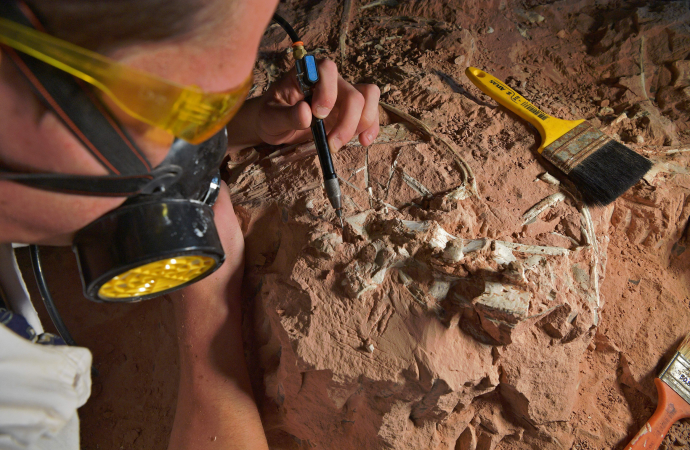An archaeological dig has unveiled a rare, 103-million-year-old dinosaur fossil, leaving researchers hopeful that it belongs to one of only two fossilized specimens found in Oregon since 2015.
Source: Newsweek
The fossil was discovered in an excavation project sponsored by the University of Oregon, according to the The Register-Guard. Quarry foreman and amateur paleontologist Greg Carr led a team of researchers on land overseen by the Bureau of Land Management four miles outside of Mitchell, Oregon in mid-June.
Carr told the outlet that a researcher’s family member visiting the site actually made the discovery. She found an intact vertebra on her own, despite having never professionally searched for fossils before.
“We set her to work moving some loose dirt,” Carr said. “And as she was shoveling into a bucket, this bone pops out. It was just great.”
University of Oregon professor Dr. Gregory Retallack spoke with Newsweek about the vertebra discovered, which he noted belonged to the ornithopod family of dinosaurs.
“Despite those long odds, we gambled and negotiated a permit to dig in a new place which looked a little more promising,” he said. “We have about a dozen more bones now, bits and pieces. Nothing big now…but some of them are quite well-formed and appear to be dinosaur bone. There’s also flying reptile and marine reptiles in the mix.
“Not quite sure if we have the smoking gun we need, we needed a tooth to properly identify the exact dinosaur, as species are defined on teeth mainly,” he did note. “But we found more bone, which is quite remarkable.”

KGW8 identified the woman who found the specimen as Christine Broz. “We were asked to kind of clear down this one area next to where they had been finding some other things,” she told the local news station. “And I just saw something that looked different from all the other rocks that I had been seeing and the texture looked different and the shape looked symmetrical.
“It was surprising, and I didn’t really understand the impact of it in the beginning. And they kept saying this is a really big deal. They were really thrilled to have this found on this site,” she said.
The specimen is believed to be a foot bone from an ornithopod dinosaur. These herbivores lived through the Late Triassic Period into the Late Cretaceous Period—between 229 million and 65.5 million years ago—when the Tyrannosaurus rex roamed the Earth. They weighed up to a ton and were over 20 feet in length, according to Brittanica.
This is the most recent dinosaur bone discovery in Oregon. Around the same area in 2014, Retallack recovered the first known dinosaur fossil in the state.
“This bone was sitting out there with all the rocks. It was pretty surprising,” Retallack told The Register-Guard in 2018. “No excavation was needed. It was just sitting among the ammonites and coil fossils.”
Although it took Retallack and his research team three years to confirm, the specimen was ultimately determined to be “an ornithopod toe bone.”
“Things come out of the woodwork when you make a discovery like this,” Retallack said at the time. “That’s what we do, and what’s great about science.”
While both bones were discovered near the Mitchell, Oregon area and determined to belong to an ornithopod, Retallack does not believe his and Carr’s finds are from the same dinosaur.
“There’s no reason to suspect it’s the same dinosaur,” Retallack told Newsweek. “Although, we only have one dinosaur so far, the ornithopod. That’s a group that includes lots of different sorts of dinosaurs.
“We haven’t had anything articulated, so we can’t say it’s the same individual,” he added. “But, we don’t have any evidence of any more than one species, and the only dinosaur we know about appears to be an ornithopod.”
“We may just have a dinosaur foot floating around here,” Carr acknowledged in a statement to KGW8, noting that during the dig the team also found 30 other bone fragments. “It may be more than that, we may have pieces of backbones and stuff.”
The Bureau of Land Management acknowledged the impressive find in a statement to Fox News but reminded the public that proper permits must be presented in order to remove any fossils from their properties.
“University of Oregon paleontologist, Dr. Greg Retallack, along with North American Research Group volunteers, discovered dinosaur bones while conducting a permitted fossil dig and excavation on Bureau of Land Management public lands in Central Oregon. The find is part of Oregon’s first dinosaur discovery,” a spokesperson for the organization told the outlet. “Until now, most fossils discovered in the state have been of mammals and these fossils are of much younger age.
“It’s important for the public to remember that removal of any dinosaur bone or other fossil bones on Bureau of Land Management public lands is illegal without permits,” they added. “More information will be provided in the coming months.”
Retallack said that while the excavation on this plot of land is completed, he is hopeful the team will get the proper permits for another dig in about a year from now.
“We’re getting more and more impressed with the quality of what we’re getting here, and are thinking of maybe doing another [dig] next year, but that will be a separate permit and maybe for an area adjacent to the one we’ve just done.”
For now, the newly discovered bone will “sit in a museum,” Retallack said.
“We’ll do all the tests we can think of to it. We try and compare it to known bones, probably take it to the Museum of the Rockies, which has a superb collection of known dinosaur species…We might start doing some CAT scans to look inside the bones too,” he said.
“The study is just beginning…The specimen will go into the Museum of Natural and Cultural History at the University of Oregon, where they’re kept in perpetuity. The science goes on!”
Newsweek reached out to the University of Oregon and the Bureau of Land Management for additional comment, but did not hear back in time for publication. Newsweek was also not immediately able to get in touch with Carr or Broz.
In May, a group of European researchers made the conclusive discovery that fossilized teeth dating back 138 million years came from a previously unknown species of extinct sea crocodiles. Another recent excavation in Wales found hundreds of preserved human skeletons buried underneath a beach.
Source: Newsweek

































Leave a Comment
You must be logged in to post a comment.